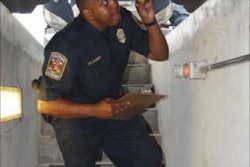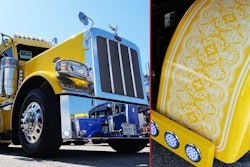Freight stabilizes as overcapacity lingers
Freight levels have stopped shrinking and the recession may be coming to an end, analysts told participants in the Commercial Vehicle Truck and Trailer Outlook and Update webinar hosted by FTR Associates Aug. 7.
But the industry has approximately 300,000 heavy-duty trucks that are either parked or underutilized, said Noel Perry, a principal with Transport Fundamentals. This overcapacity situation may not improve until the economy shows considerable growth – around 3 percent, possibly not until late next year. “The bad news is we don’t get the kind of capacity utilization numbers we need to improve rates until into 2011,” Perry said.
Freight stabilization is a reflection of the recession coming to an end, analysts said. “Our expectation is that this current quarter will show growth at about 2 percent [gross domestic product],” said Bill Witte, co-director of the Center for Econometric Research, the primary engine FTR uses to drive its forecasts.
While Witte is optimistic about the remainder of this year, “if you go beyond the next couple of quarters, there is lots to be concerned about,” he said. One reason is that consumers – hit hard by the tough economy – are saving more and spending less. At the same time, the Fed is pumping liquidity into the economy.
Turning to the Class 8 truck market, Eric Starks, president of FTR Associates, said fleets continue to overbuy equipment relative to the amount of available freight. “This will continue to be problematic,” he said. “It will take a large amount of time to eat up 300,000 trucks unless you have a significant uptick in economy.”
FTR predicts about 105,000 Class 8 factory shipments to the North American market in 2009, rising to 133,000 in 2010 and 198,000 in 2011.
Starks also noted orders for engine components are exceeding new truck activity. “It appears that OEMs are willing to put cash on the table to put these engines in inventory,” he said. This means 2007 technology engines will be placed in trucks longer than the industry expected, delaying the changeover to the 2010 engines, he said.
– Linda Longton
No privacy for drug, alcohol tests
As of Aug. 31, CDL holders who take return-to-duty or follow-up tests for alcohol or drugs must be directly observed during testing.
The Department of Transportation published a final rule July 30 reinstating that the test observer must check for prosthetic or other cheating devices. Federal reports had indicated that cheating devices were widely available and fairly effective.
The DOT returned the mandate to the regulation following a unanimous ruling by the District of Columbia’s U.S. Court of Appeals in favor of the department, following a challenge by BNSF Railway Co.
DOT data indicated “the violation rate for return-to-duty and follow-up testing is
two to four times higher than that of random testing.”
The court rejected the petitioners’ proposal to maintain the status quo, which would make direct observation optional for employers. It supported the department’s determination that employers, concerned over labor management agreements and not wanting to upset employees, rarely exercise this right.
Also, the provision making direct observation optional in return-to-duty and follow-up situations was effective long before the current threats to the integrity of urine testing became known.
“That was before the Whizzinator and its like,” the court stated. “Given the proliferation of such cheating devices, here we have a very different record.”
– Jill Dunn
Congress weighs border program
Progress hasn’t been made in resuming the Mexico-United States trucking program, but the Senate is expected to consider a long-term transportation funding bill this month that provides funds for it if congressional concerns are met.
The Senate Appropriations Committee-approved FY2010 omnibus transportation act includes program funding, contingent on resolving congressional questions.
“The Committee notes that the Congress acted earlier this year to suspend the Mexican trucking pilot program because of serious and legitimate safety concerns, and expects that the administration will not commence another Mexican trucking pilot program until those concerns have been addressed and resolved,” the Senate committee report says. It “urges the administration to work expeditiously with the Mexican government” to re-establish a safe program.
A new Rasmussen Reports national telephone survey indicates 19 percent of Americans say the U.S. Congress should let trucks from Mexico cross the border and carry loads on U.S. highways, while 66 percent favor the ban and 15 percent are uncertain.
Twenty-eight percent of Democrats think the border should be opened, but only 11 percent of Republicans and 16 percent of those not affiliated with either party are in favor of it.
The American Trucking Associations supports program resumption, while the Owner-Operator Independent Driver Association opposes it.
– Jill Dunn
Bills would fund truck technology
Trucking groups have praised legislation that would allow a maximum tax credit of $3,000 for buying idling reduction units, while another bill is moving through Congress that would authorize $590 million in research on medium to heavy-duty truck technologies.
The ATA and the OOIDA supported the Idling Reduction Tax Credit Act of 2009, or HR 3383. The legislation would offer a 50 percent tax credit, capped at $3,000 for truckers buying devices such as auxiliary power units.
Another bill, the “Advanced Vehicle Technology Act of 2009,” or HR 3246, would authorize federal research on medium to heavy-duty truck technologies. The legislation would back investments in technologies that improve fuel efficiency and reduce emissions.
– Jill Dunn
Daimler sets its 2010 engine surcharges
Daimler Trucks North America on Aug. 6 announced pricing for meeting U.S. Environmental Protection Agency 2010 standards with its Detroit Diesel BlueTec or Cummins mid-range engine emissions technologies.
Emissions technology surcharges for vehicles equipped with Detroit Diesel DD15 and DD16 big bore engines, as well as the medium bore DD13, will be $9,000 per vehicle. A surcharge of $7,300 will be added to vehicles equipped with the Cummins ISC8.3 engine, and a $6,700 surcharge will be added to the price of vehicles equipped with Cummins ISB6.7 engines.
The surcharges reflect costs associated with adding selective catalytic reduction, which Daimler says will significantly improve fuel economy compared to EPA 2007 engines, while meeting the stringent, near-zero emission standards set by the EPA that take effect Jan. 1, 2010.
SCR technology consists of an after-treatment catalyst system that allows engine exhaust to be treated with diesel exhaust fluid that reduces NOx into nitrogen and water. Since virtually no base engine changes are needed for SCR to work, service technicians will also find no engine maintenance changes for EPA 2010, Daimler says.
– Staff reports
Navistar announces engine-related price hikes
The cost of International Trucks equipped with MaxxForce 11 and 13 big bore advanced exhaust gas recirculation diesel engines will increase $8,000 with next year’s emissions-mandated change, while trucks equipped with the MaxxForce 7, DT, 9 and 10 will increase $6,000, Navistar announced.
In a July 28 conference call with industry journalists, Jack Allen, president of the Navistar North American Truck Group, responded to claims that advanced EGR would increase underhood temperatures and reduce engine durability and reliability. On the contrary, Navistar will be using a two-stage EGR cooler that will produce cooler air than the current engine, he said.
Navistar officials argue that the acquisition cost with the MaxxForce advanced EGR technology is the only additional cost that customers will incur as opposed to the diesel exhaust fluid and additional maintenance and weight required with competitors’ systems based on selective catalytic reduction.
Navistar’s price increases will be applied as a non-discountable surcharge applied to each vehicle’s base price.
– Avery Vise
Safety agency vows to fix CDL database
The Federal Motor Carrier Safety Administration says it will correct CDL database shortcomings, including not posting driving convictions in the time required and inadequately protecting driver data.
The agency’s oversight office, the Office of Inspector General, issued audit recommendations for the Commercial Driver’s License Information System July 30. It agreed with recommendations that it improve the database so unqualified drivers will be less able to obtain CDLs or renewals and drivers’ information will be better protected against hackers.
The FMCSA oversees CDLIS, which is administered by the American Association of Motor Vehicle Administrators. The system does not contain driver histories, but directs inquiries to the state of record. Completeness of driver conviction data depends on the courts providing DMVs and department officials updating driver histories promptly.
The auditors estimated 20 percent of active CDL holders, almost 100,000 drivers, have convictions that were not posted within regulation time frames.
Since 2005, notification to another state of traffic violations was required within 30 days of conviction. States must post convictions within 10 days of the conviction if it occurred in the same state, or within 10 days of notification of conviction if it is from another state.
The OIG also found agency officials have not enforced requirements that systems be accredited as adequately secured or included CDLIS-Access in its systems inventory. Federal regulations require systems be inventoried and authorized or accredited as secured before beginning or significantly changing system processing, and reauthorized every three years.
– Jill Dunn
Customers cautious about buying new trucks
Despite new emissions regulations to be implemented in 2010, Class 8 customers remain cautious about the prospect of purchasing new trucks in the next 12 months, according to the J.D. Power and Associates 2009 Heavy-Duty Truck Customer Satisfaction Study.
The study finds the percentage of Class 8 customers who say they “definitely will” purchase a new Class 8 truck in the next 12 months is down from 25 percent in 2008 to only 16 percent in 2009. This marks the lowest purchase intention level since 2002. Sales, which have plummeted since 2008, continue to be slow in 2009.
“Freight tonnage continues to decline, and fleets are increasing the length of time they keep their trucks operating – both of which lower demand for new trucks,” said Brian Etchells, a senior research manager at J.D. Power and Associates.
– Staff reports
Trucks banned from highway near L.A.
California Gov. Arnold Schwarzenegger signed into law a bill banning large trucks from running on State Route 2 in Los Angeles County near where an auto carrier slammed into several vehicles April 1, killing a man and his daughter.
The law fines commercial vehicles with three or more axles, or weighing more than 9,000 pounds, $1,000 if caught traveling on the section between Big Pines Highway and Interstate 210 in La Ca










